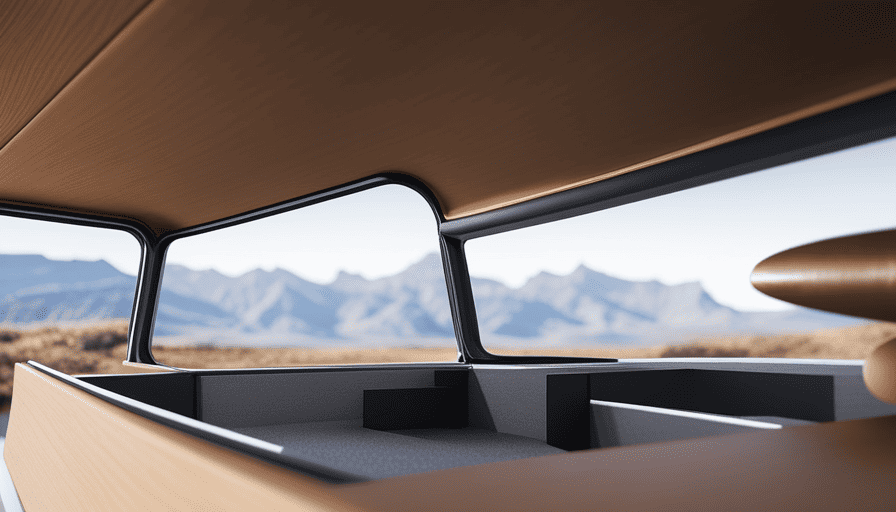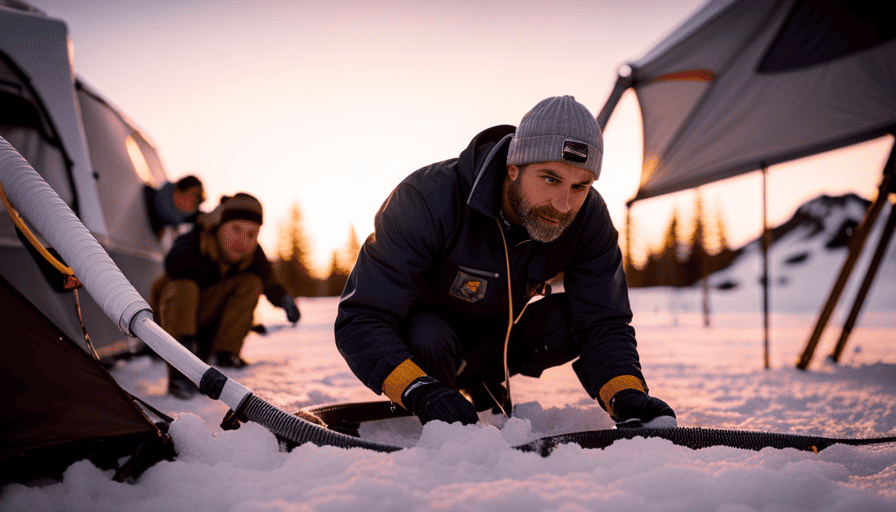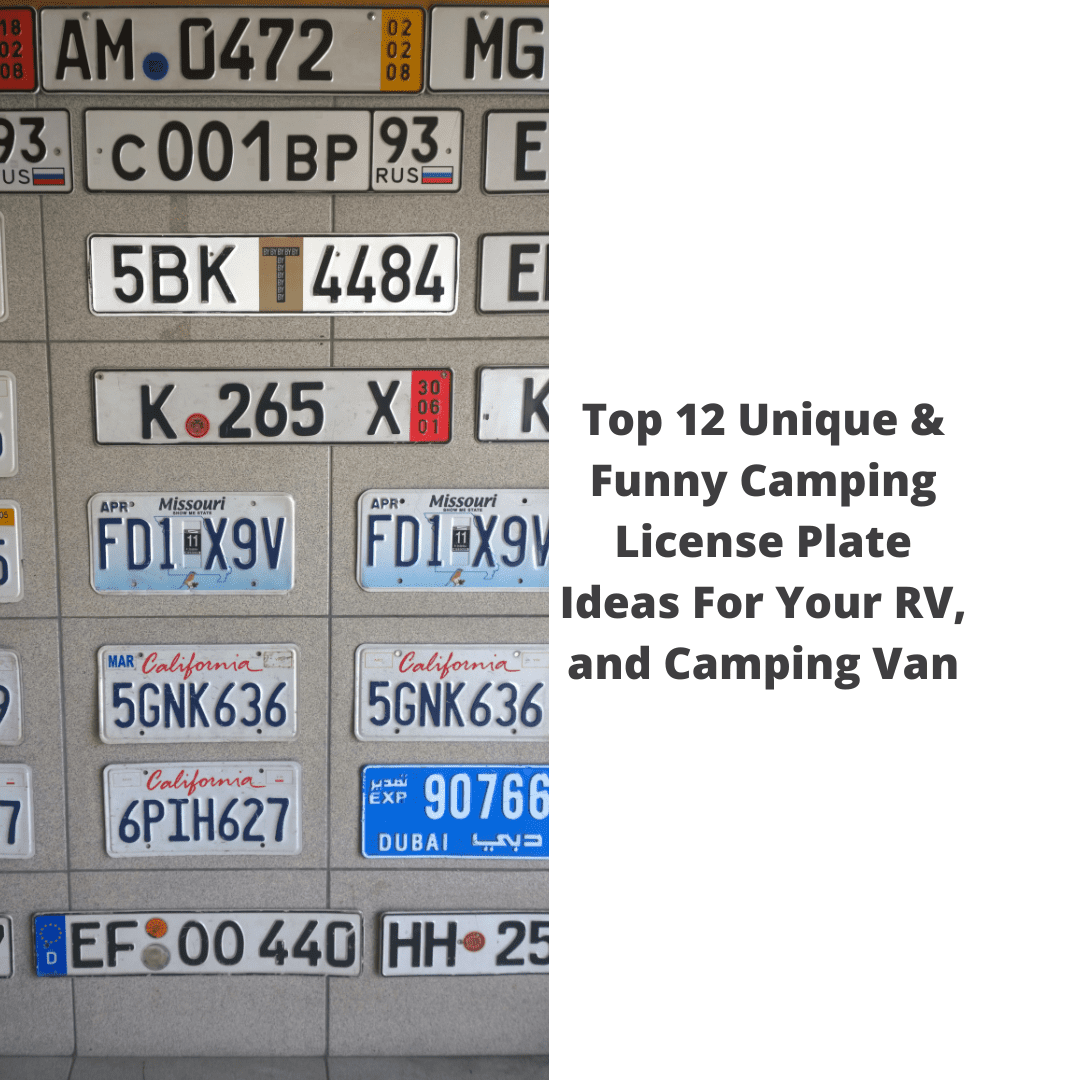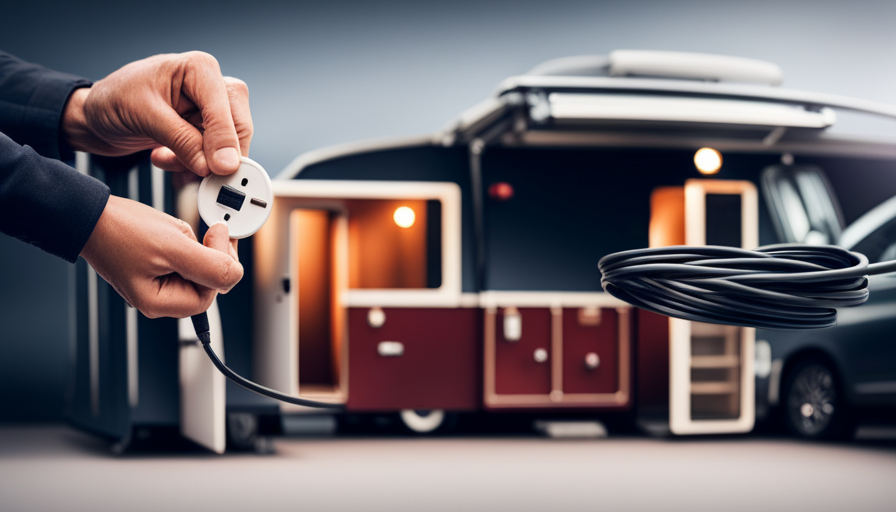As I gazed upon my reliable pickup truck, with its empty bed ready for a new purpose, a rush of excitement filled me. It was time to convert this modest vehicle into something remarkable – a pickup camper shell that would enable me to go on endless adventures.
Building a pickup camper shell is no small feat, but with the right tools, materials, and a little know-how, it can be a rewarding endeavor. In this article, I will guide you through the step-by-step process of creating your very own camper shell, designed to cater to your specific needs and preferences.
From assessing your pickup truck and gathering the necessary materials, to constructing the frame, installing insulation and wiring, and adding interior features and storage – I will leave no stone unturned.
Together, we will navigate the intricacies of installing exterior finishes and roofing, ensuring a durable and weather-resistant shell.
So, grab your tools and let’s embark on this journey together. Get ready to unlock the full potential of your pickup truck and enjoy the freedom of a homemade camper shell. Adventure awaits!
Key Takeaways
- Assess the dimensions and weight distribution of your pickup truck to determine the size and shape of the camper shell.
- Gather materials and tools such as plywood, insulation, screws, hinges, circular saw, drill, and measuring tape.
- Customize the layout to include a comfortable sleeping area, functional kitchenette, and ample storage space.
- Use visually appealing and weather-resistant exterior finishes and roofing materials.
Assess Your Pickup Truck and Determine Your Needs
Take a look at your pickup truck and figure out what you’ll need for your camper shell. Assessing truck dimensions is crucial in determining the size and shape of the camper shell that will fit properly.
Measure the length, width, and height of your truck bed to ensure a snug fit. Additionally, consider the weight distribution of your truck. This is important because a camper shell adds extra weight to your vehicle, which can affect its performance and stability. Make sure your truck can safely handle the additional load.
Once you have assessed your truck and determined your needs, it’s time to gather the materials and tools necessary for building your camper shell. This includes plywood or a suitable alternative for the shell structure, insulation materials, screws, hinges, and a variety of tools such as a circular saw, drill, and measuring tape. Having all the necessary materials and tools will make the construction process smoother and more efficient.
With the truck dimensions assessed and materials and tools gathered, you are now ready to move on to the next step of building your pickup camper shell.
Gather Materials and Tools
To get started, you’ll need to round up all the necessary supplies and equipment for this project. Choosing the right materials is crucial to ensure the durability and functionality of your pickup camper shell.
For the shell’s framework, opt for strong and lightweight materials such as aluminum or fiberglass. These materials are resistant to rust and can withstand harsh weather conditions.
Additionally, you’ll need plywood sheets for the walls, roof, and floor of the camper shell. Make sure to select plywood that’s sturdy and moisture-resistant.
Proper use of tools is essential to successfully build your camper shell. You’ll require a variety of tools, including a tape measure, circular saw, drill, jigsaw, and screwdriver. These tools will help you accurately measure and cut the materials, drill holes, and secure the components together.
Safety equipment such as goggles, gloves, and a dust mask should also be worn while working with these tools.
With all the necessary materials and tools gathered, you’re now ready to design your camper shell layout. This involves planning the interior layout, determining the size and placement of windows, and considering storage options.
Design Your Camper Shell Layout
Crafting the perfect layout for your dream adventure-on-wheels will ignite your imagination and leave you craving the freedom of the open road. When designing your camper shell layout, it’s essential to consider your specific needs and preferences.
Here are three important factors to customize your layout and maximize space:
-
Functionality: Plan the layout around your intended activities. Consider the need for a comfortable sleeping area, a functional kitchenette, and storage space for your gear. Ensure that each component is strategically placed to optimize efficiency and convenience.
-
Ergonomics: Take into account the ergonomics of the space. Design the layout to provide ample headroom, legroom, and ease of movement. Utilize modular furniture and foldable components to create a versatile and adaptable living space.
-
Storage Solutions: Incorporate clever storage solutions to make the most of the available space. Use overhead compartments, under-bed storage, and built-in shelving units to keep your belongings organized and easily accessible.
Customizing your layout and maximizing space is crucial when building a pickup camper shell. With careful planning and attention to detail, you can create a layout that perfectly suits your needs and enhances your travel experiences.
As you finalize your design, it’s time to move on to the next step of building the frame and structure.
Build the Frame and Structure
Investigate whether or not the theory holds true by constructing a sturdy frame and structure for your adventure-on-wheels. Building a pickup camper shell requires using the right building techniques and following a precise construction process.
To create a solid foundation, start by measuring and cutting the lumber according to your camper shell design. Use strong and durable materials such as plywood or aluminum to ensure the frame’s stability. Connect the pieces together using screws, bolts, or brackets, depending on your preference and the materials used. Reinforce the joints with metal brackets or corner braces for added strength.
As you build the frame, pay attention to the angles and dimensions to ensure a proper fit. Use a level to ensure everything is straight and square. You may also need to add cross supports or additional framing for added stability, especially if you plan on adding heavy appliances or equipment inside the camper shell.
Once the frame is complete, you can move on to constructing the walls and roof. Attach the walls to the frame using screws or nails, making sure they are securely fastened. For the roof, consider using a lightweight yet durable material such as fiberglass or corrugated metal. Install the roof by attaching it to the frame and sealing any gaps to prevent water leakage.
With the frame and structure complete, you can now transition into the next section about installing insulation and wiring.
Install Insulation and Wiring
Now that I’ve completed the frame and structure, it’s time to focus on installing insulation and wiring to ensure a comfortable and functional interior for my adventure-on-wheels.
To start with the insulation, there are a few techniques that can help keep the inside temperature regulated. One popular option is using foam board insulation, which can be cut to fit the walls and ceiling of the camper shell. Another method is using spray foam insulation, which expands to fill in any gaps or crevices. This helps to prevent heat loss and keep the interior cozy during colder months.
When it comes to wiring, safety should always be a top priority. I recommend starting by planning out the electrical system and creating a detailed diagram. This will help ensure that everything is properly connected and avoid any potential hazards. It’s also important to use the right gauge of wire for each circuit and to properly secure and protect all electrical connections.
Now that the insulation and wiring are taken care of, the next step is to add windows and ventilation. This will not only provide natural light and fresh air, but also enhance the overall aesthetic of the camper shell.
Add Windows and Ventilation
To create a breath of fresh air and a glimpse of the world outside, you’ll want to let the light in and let the wind whisper its stories by adding windows and ventilation. When it comes to window placement, it’s important to consider both aesthetics and functionality. Placing windows strategically will not only enhance the overall look of your pickup camper shell but also provide optimal views and natural light. To make your decision easier, refer to the table below for some popular window placement options.
| Window Placement | Benefits |
|---|---|
| Rear Window | Offers a panoramic view and allows for easy ventilation. |
| Side Windows (Driver and Passenger) | Provides privacy and allows fresh air to circulate throughout the camper. |
| Roof Ventilation | Enhances airflow and reduces condensation inside the camper. |
| Overhead Windows | Offers additional natural light and a sense of spaciousness. |
| Front Window | Allows for a clear view while driving and adds to the overall aesthetics of the camper. |
In addition to windows, incorporating ventilation options is crucial for a comfortable camping experience. Consider installing vents, such as roof vents or side vents, to ensure proper airflow inside the camper. This will help regulate temperature and minimize moisture buildup. By adding windows and ventilation, you are creating an inviting and refreshing atmosphere inside your pickup camper shell. Next, we will discuss how to construct interior features and storage, allowing you to optimize your space efficiently.
Construct Interior Features and Storage
Create a cozy and organized interior oasis by maximizing storage space and designing functional features inside your pickup camper. When it comes to a compact living space like a camper shell, every inch counts. Maximizing space is essential, and there are plenty of DIY storage solutions that can help you achieve this goal.
One way to maximize space is by utilizing vertical storage. Install shelves or cabinets that go all the way up to the ceiling, allowing you to store items that aren’t frequently used. You can also incorporate storage bins or baskets under the bed or seating areas to make the most of every nook and cranny.
Another great storage solution is to build in drawers or compartments underneath the kitchen counter or along the sides of the camper. These can be used to store kitchen utensils, toiletries, or any other small items that you need to keep organized.
To make your camper even more functional, consider adding features like a fold-out table or a built-in desk. These can be used for dining, working, or even as a multipurpose surface.
With these DIY storage solutions and functional features in place, your pickup camper will become a well-organized and efficient space.
In the next section, we’ll discuss how to install exterior finishes and roofing to complete the construction process.
Install Exterior Finishes and Roofing
With the installation of exterior finishes and roofing, your personalized pickup camper will take on a polished and weather-resistant appearance, perfect for your adventurous journeys ahead.
When it comes to the exterior finishes, it’s important to select materials that are not only visually appealing but also durable and capable of withstanding various weather conditions. One crucial aspect to consider is waterproofing techniques to ensure that your camper remains dry even during heavy rain or snowfall.
To achieve optimal waterproofing, it’s recommended to apply a high-quality sealant to all exterior seams, joints, and gaps. This will prevent water from seeping into the camper and causing damage. Additionally, consider using weather-resistant paint or coatings to protect the exterior surfaces from UV rays and other environmental factors.
When choosing roofing materials, it’s essential to prioritize durability and longevity. Common options include fiberglass, aluminum, or even rubber roofing. Each material has its advantages and disadvantages, so it’s important to research and select the one that best suits your needs.
Once the exterior finishes and roofing are installed, it’s time to test and make adjustments as necessary. This will ensure that your pickup camper is fully functional and ready for your upcoming adventures.
Test and Make Adjustments
Explore the functionality and adaptability of your personalized adventure rig by thoroughly testing and fine-tuning its components and features. To ensure a successful build, follow these testing methods and make necessary adjustments:
-
Water Leak Test: Apply a hose to the exterior of the camper shell and inspect for any signs of water penetration. Check all seams, joints, and corners for potential leaks. Use a sealant to fix any problem areas.
-
Weight Distribution Test: Load your camper shell with the necessary gear and supplies. Drive over various terrains to assess how the weight is distributed. Make adjustments by repositioning items or adding weight to achieve optimal balance.
-
Wind Resistance Test: Take your pickup camper shell to an open area with strong winds. Observe how it handles the wind forces. Make modifications to the design or add reinforcements if needed to improve stability.
-
Interior Space Optimization Test: Spend a night or two inside the camper shell to evaluate its comfort and functionality. Identify areas that can be improved for better organization and storage.
By thoroughly testing and making adjustments, you can ensure that your pickup camper shell is reliable and tailored to your specific needs. Now, let’s move on to the next section and learn how to fully enjoy your homemade creation.
Enjoy Your Homemade Pickup Camper Shell
Now that I’ve perfected my personalized adventure rig, it’s time to fully immerse myself in the joy of my homemade getaway haven.
There are so many benefits to building your own camper shell. Not only do you save money, but you also have the freedom to customize it exactly to your liking.
Here are some tips for making the most out of your DIY camper shell.
First and foremost, think about the layout of your camper shell. Consider how you’ll use the space and what features are important to you. Will you need a bed, storage compartments, or a kitchenette? Plan accordingly and make sure to measure everything accurately before starting the construction process.
Next, think about the materials you’ll use. Lightweight and durable materials like aluminum or fiberglass are popular choices. Make sure to use quality materials that can withstand the elements and provide proper insulation.
When customizing your camper shell, don’t forget about functionality. Think about adding features like solar panels for power, a ventilation system for airflow, and windows for natural light. Also, consider adding hooks, shelves, and storage compartments to maximize the use of space.
Lastly, don’t be afraid to get creative with the design. Add personal touches like artwork, curtains, or a cozy seating area. This is your own little home on wheels, so make it reflect your style and personality.
By following these tips, you can create a camper shell that’s not only functional but also a reflection of your personal taste. Enjoy the freedom and convenience of your homemade getaway haven!
Frequently Asked Questions
How much weight can my pickup truck support with a camper shell?
My pickup truck can handle an astonishing amount of weight with a camper shell! The weight capacity of a pickup truck varies depending on several factors. These include the truck’s make, model, and year, as well as the suspension system and tires.
Additionally, the truck’s overall condition and any modifications made can affect its weight capacity. It’s crucial to consult your vehicle’s manual or contact the manufacturer to determine the specific weight capacity of your pickup truck.
Can I use a camper shell on a truck with a short bed?
Yes, a camper shell can be used on a truck with a short bed. However, it’s important to be aware of the limitations that come with a short bed. Due to the reduced length, the space inside the camper shell may be limited, affecting comfort and storage capacity. An alternative option for trucks with short beds is to consider a slide-in truck camper, which is specifically designed to fit shorter bed lengths.
What kind of tools do I need to build a pickup camper shell?
To build a pickup camper shell, you’ll need a set of essential tools. These include a measuring tape, circular saw, jigsaw, drill, screwdriver, hammer, level, and a staple gun.
Additionally, you’ll require materials such as plywood, insulation, screws, hinges, and sealant.
The construction process involves measuring the truck bed, cutting the plywood to size, assembling the walls and roof, installing windows and doors, and sealing all joints to ensure a watertight camper shell.
How long does it typically take to build a pickup camper shell?
Typically, it takes about two to three weeks to build a pickup camper shell, depending on your skill level and the complexity of the design. However, this timeline can vary.
When insulating a pickup camper shell, it’s essential to choose the right materials and ensure proper installation to prevent condensation and maintain a comfortable temperature inside. Common mistakes to avoid include using inadequate insulation and not sealing all gaps and seams effectively.
Are there any regulations or permits required for using a homemade pickup camper shell on public roads?
Yes, there are regulations and permits required for using a homemade pickup camper shell on public roads. These regulations vary by location, but typically involve safety standards such as proper lighting, reflectors, and secure attachment to the pickup truck.
Additionally, some areas may require permits for oversized or modified vehicles. It’s important to research and comply with the specific regulations and permits in your jurisdiction to ensure legal and safe use of a homemade pickup camper shell on public roads.
Conclusion
Well, folks, we’ve reached the end of this epic journey of building a pickup camper shell. I must say, it’s been quite the adventure!
From assessing our trusty pickup truck to gathering materials and tools, we’ve been through it all. And let’s not forget the heart-pounding moments of constructing the frame and installing insulation and wiring.
But now, my friends, we can proudly bask in the glory of our homemade masterpiece. So go ahead, hop in and hit the road, ’cause you’re now the proud owner of the ultimate pickup camper shell!










